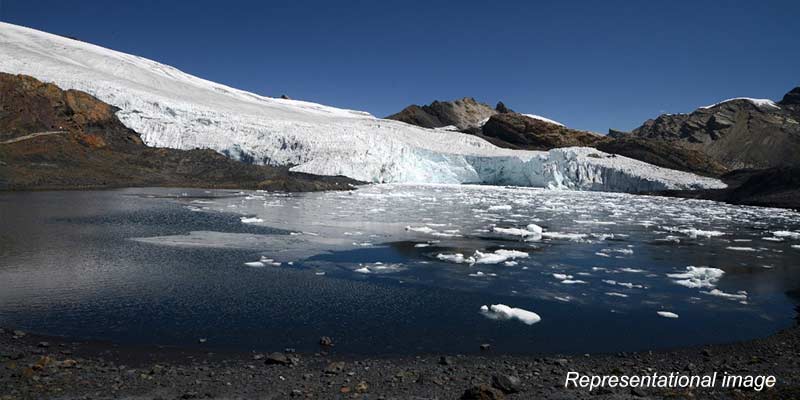- World
- Nov 24
Peru lost over half of its glacier surface in six decades
• Peru has lost 56 per cent of its glacier surface in the last six decades due to climate change.
• About 175 glaciers became extinct between 2016 and 2020.
• Peru holds 68 per cent of the world’s tropical glaciers and warming temperatures have led to melting and the creation of new mountain lagoons that risk overflowing and flooding
• This was revealed by a report of Peru’s National Institute of Research of Mountain Glaciers and Ecosystems.
• The report uses satellite imagery until 2020 and shows that 2,084 glaciers are covering 1,050 square kilometers in Peru, compared to the 2,399 square kilometers of ice and snow in 1962.
• The factor that causes the greatest impact is the increase in the average global temperature, causing an accelerated retreat of glaciers, especially those in tropical areas.
• According to the report, 164 lagoons have been formed or are in the process of formation in the last four years, bringing the number of glacial lagoons up to 8,466, covering about 1,081 square kilometers.
• Nearly all of Peru’s tropical glaciers are above 6,000 meters (19,685 feet) above sea level while the new lagoons are at an altitude of between 4,000 and 5,000 meters.
The critical importance of glaciers for sustaining life on Earth
• Covering about 10 per cent of the planet’s surface, ice masses are crucial for sustaining life on Earth.
• Glacial ecosystems provide vital resources to a significant proportion of the global population because of their high biological diversity and ecosystem services such as sediment sinks, freshwater reservoirs and habitats for biodiversity.
• The benefits include freshwater for domestic use, agriculture, industry and hydropower, as well as climate regulation.
• About 50 per cent of the global biodiversity hotspots on the planet are located in basins drained by glaciers and contain a third of the entire terrestrial species diversity.
• Often referred to as natural “water towers”, glaciers in mountains provide lowlands with essential freshwater supply.
• The High Mountain ranges of Asia are covered by approximately 100,000 km² of glacier ice and feed the great rivers of Central Asia (Amu Darya and Syr Darya) and South Asia (Brahmaputra, Ganges and Indus), Southeast Asia (Huang He, Mekong and Yangtze).
• The Antarctic and Greenland ice sheets are the largest bodies of ice in the world and play an important role in the global climate system. They serve as a global thermostat regulating ocean circulation, and their white ice cover cools the atmosphere by reflecting sunlight (albedo effect).
• Glaciers are a sensitive indicator of climate change and one that can be easily observed. Although there are around 200,000 glaciers on the planet, only a few hundred are currently monitored in-situ because they are often difficult to access. Satellite imagery has thus become one of the most valuable methods to keep track of the world’s retreating glaciers.
The dynamics of glaciers
• Glaciers are bodies of moving ice that develop as snow accumulated in cold places compacts and recrystallizes. The formation of a glacier takes decades to millennia, and its size varies depending on the amount of ice it retains throughout its lifespan.
• Each year, glaciers gain and lose mass. They gain mass from snow and precipitation in their upper portions (accumulation zone) and lose mass in their lower portions (ablation zone) by partially melting in summer. In marine-terminating glaciers, they also lose mass by calving icebergs that float away.
• The balance between accumulation and ablation is the mass balance of the glacier. If accumulation is greater than ablation, then the glacier has a positive mass balance and will advance. If ablation is greater than accumulation, then the glacier has a negative mass balance and will retreat.
• The glacier terminus is the end of a glacier at any given point in time. Changes in the terminus position are often used as an important indicator for monitoring the long-term dynamic behavior of glaciers.
• Earth’s glaciers vary incredibly in their sizes and shapes, ranging from small cirque glaciers to ice masses hundreds of meters thick in mountains and ice sheets.
There are two main groups of glaciers:
i) Unconstrained glaciers have a morphology and flow pattern largely independent of underlying topography, like polar ice caps or the Antarctic and Greenland ice sheets.
ii) Constrained glaciers have a morphology and flow pattern strongly dependent on underlying topography, like ice field, cirque, valley, piedmont and tidewater glaciers.
Manorama Yearbook app is now available on Google Play Store and iOS App Store

